
Lycaena phlaeas, the small copper, American copper, or common copper, is a butterfly of the Lycaenids or gossamer-winged butterfly family. According to Guppy and Shepard (2001), its specific name phlaeas is said to be derived either from the Greek φλέγω (phlégo), "to burn up", or from the Latin floreo, "to flourish".

The large copper is a butterfly of the family Lycaenidae. L. dispar has been commonly arranged into three subspecies: L. dispar dispar, (single-brooded) which was commonly found in England, but is now extinct, L. d. batavus, (single-brooded) can be found in the Netherlands and has unsuccessfully been reintroduced into the United Kingdom, and lastly, L. d. rutilus, (double-brooded) which is widespread across central and southern Europe. The latter has been declining in many European countries, due to habitat loss. Currently L. dispar is in severe decline in northwest Europe, but expanding in central and northern Europe.

The purple-shot copper is a butterfly in the family of the Lycaenidae or copper butterflies and in the genus of the Lycaena.

The scarce copper is a butterfly of the family Lycaenidae.

The purple-edged copper is a butterfly of the family Lycaenidae.
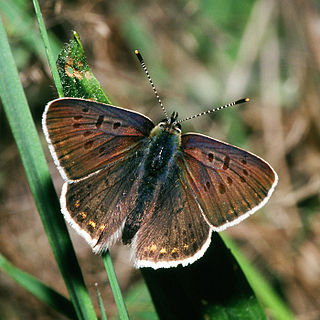
Lycaena tityrus, the sooty copper, is a butterfly of the family Lycaenidae. It is found in Europe.
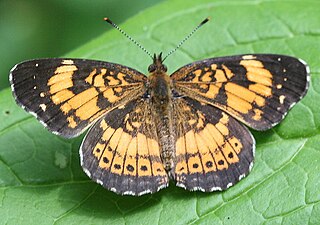
Chlosyne nycteis, the silvery checkerspot, is a species of Nymphalinae butterfly that occurs in North America. It is listed as a species of special concern in Connecticut and Maine, and is believed extirpated in Connecticut, Massachusetts, and New Hampshire.

Lycaena dorcas is a species of butterfly in the family Lycaenidae, the gossamer-winged butterflies. Its common names include dorcas copper and cinquefoil copper. The species was first described by William Kirby in 1837. It is native to North America. The species L. dospassosi was once included in L. dorcas.

Lycaena epixanthe, also known as the bog copper or cranberry-bog copper, is a North American species of butterfly in the family Lycaenidae. Adults like to sip drops of dew clinging to leaves and almost exclusively nectar on their host plant, cranberries. Because of this, bog coppers will spend their entire lives within the area of a single acid bog. Even though their flight is weak and close to the ground, bog coppers are hard to catch because of the habitat in which they live. Also, 85% of the bog coppers life span is spent in the egg. It is listed as a species of special concern in the US state of Connecticut.
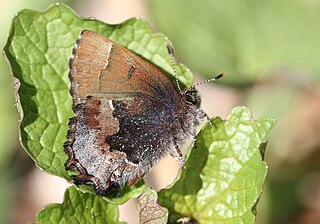
Callophrys henrici, the Henry's elfin or woodland elfin, is a North American butterfly in the family Lycaenidae. In Canada it is found from southern Manitoba to southern Nova Scotia. It has two main groups of populations in the United States; the first is found along the Atlantic Coast and uses various hollies (Ilex) as host plants; and the second is found mainly in the north and the Appalachians where they use redbud as a host plant. Henry's elfin is increasing in New England because of an introduced buckthorn it now uses as a host plant. It is listed as a species of special concern in the US state of Connecticut.

Speyeria atlantis, the Atlantis fritillary, is a butterfly of the family Nymphalidae of North America. It is from the Avalon Peninsula of Newfoundland and Labrador to northern British Columbia, across the northern United States south as far as Colorado and West Virginia. It resides as far north as James Bay. The species is listed as endangered in Connecticut.

Celastrina neglecta, the summer azure, is a butterfly of the family Lycaenidae. It is found in North America. Layberry, Hall, and Lafontaine, in The Butterflies of Canada, describe the species:
The upper surface is pale blue with an extensive dusting of white scales, especially on the hindwing. In some females the blue is almost entirely replaced by white with a small amount of blue near the wing bases. Females have a broad blackish-grey band on the outer third and costa of the forewing. The underside is chalky white to pale grey with tiny dark grey spots and a zigzagged submarginal line on the hindwing.

Callophrys irus, the frosted elfin, is a species of Lycaenidae that is native to North America.

Erynnis horatius, commonly known as Horace's duskywing, is a species of butterfly in the family Hesperiidae. It is found in the United States from Massachusetts to Florida, and west to eastern South Dakota, the Gulf Coast, south-eastern Utah, Colorado, north-eastern Arizona, and New Mexico. It is listed as a species of special concern in the US state of Connecticut.

Speyeria coronis, the Coronis fritillary, is a butterfly of the family Nymphalidae of North America. It is common from Baja California to Washington and east to Colorado and western South Dakota and once reported in Alberta.

Lycaena rubidus, the ruddy copper, is a butterfly of the family Lycaenidae. It is found in the western mountains of North America. Adults lay their eggs on plants of the genus Rumex, which later become the larval food plants. This butterfly gets its name from the brightly colored wings of the males, which are important in sexual selection. Its larvae exhibit mutualism with red ants, and are often raised in ant nests until they reach adulthood. Adults are on wing from mid-July to early August.
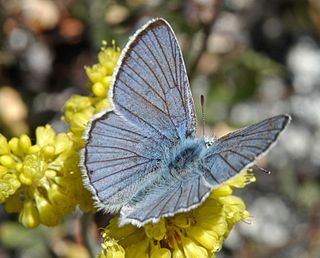
Lycaena heteronea, the blue copper, is an American butterfly that belongs to the gossamer-winged family. The butterfly is named so because of the bright blue hue of the upper side of the males' wings. Females are brown on their upper side. Both sexes are white with black spots on the underside of the wings. Blue coppers are seen on the west coast of the United States and the southwest region of Canada, particularly British Columbia and Alberta. The males are often confused with Boisduval’s blue, another species of butterfly. Blue coppers prefer to live in areas where species of Eriogonum are found. Blue copper larvae sometimes form mutualistic associations with Formica francoeuri, an ant species.
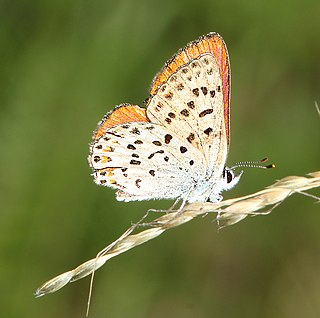
Lycaena gorgon, known generally as the gorgon copper or stream water-crowfoot, is a species of copper in the butterfly family Lycaenidae. It is found in North America, mainly in California.



















